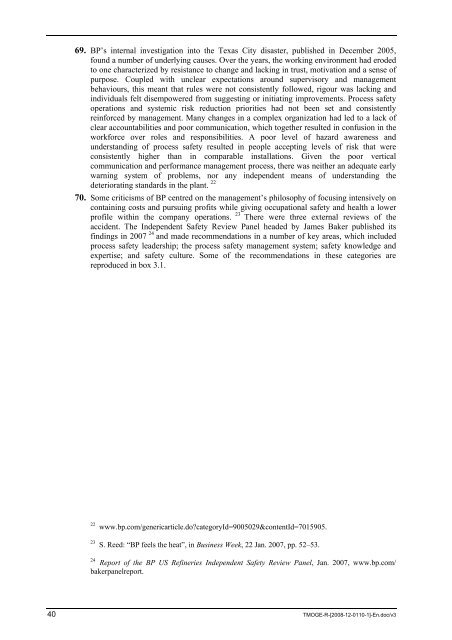wcms_161662
wcms_161662
wcms_161662
Create successful ePaper yourself
Turn your PDF publications into a flip-book with our unique Google optimized e-Paper software.
69. BP’s internal investigation into the Texas City disaster, published in December 2005,<br />
found a number of underlying causes. Over the years, the working environment had eroded<br />
to one characterized by resistance to change and lacking in trust, motivation and a sense of<br />
purpose. Coupled with unclear expectations around supervisory and management<br />
behaviours, this meant that rules were not consistently followed, rigour was lacking and<br />
individuals felt disempowered from suggesting or initiating improvements. Process safety<br />
operations and systemic risk reduction priorities had not been set and consistently<br />
reinforced by management. Many changes in a complex organization had led to a lack of<br />
clear accountabilities and poor communication, which together resulted in confusion in the<br />
workforce over roles and responsibilities. A poor level of hazard awareness and<br />
understanding of process safety resulted in people accepting levels of risk that were<br />
consistently higher than in comparable installations. Given the poor vertical<br />
communication and performance management process, there was neither an adequate early<br />
warning system of problems, nor any independent means of understanding the<br />
deteriorating standards in the plant. 22<br />
70. Some criticisms of BP centred on the management’s philosophy of focusing intensively on<br />
containing costs and pursuing profits while giving occupational safety and health a lower<br />
profile within the company operations. 23 There were three external reviews of the<br />
accident. The Independent Safety Review Panel headed by James Baker published its<br />
findings in 2007 24 and made recommendations in a number of key areas, which included<br />
process safety leadership; the process safety management system; safety knowledge and<br />
expertise; and safety culture. Some of the recommendations in these categories are<br />
reproduced in box 3.1.<br />
22 www.bp.com/genericarticle.do?categoryId=9005029&contentId=7015905.<br />
23 S. Reed: “BP feels the heat”, in Business Week, 22 Jan. 2007, pp. 52–53.<br />
24<br />
Report of the BP US Refineries Independent Safety Review Panel, Jan. 2007, www.bp.com/<br />
bakerpanelreport.<br />
40 TMOGE-R-[2008-12-0110-1]-En.doc/v3














